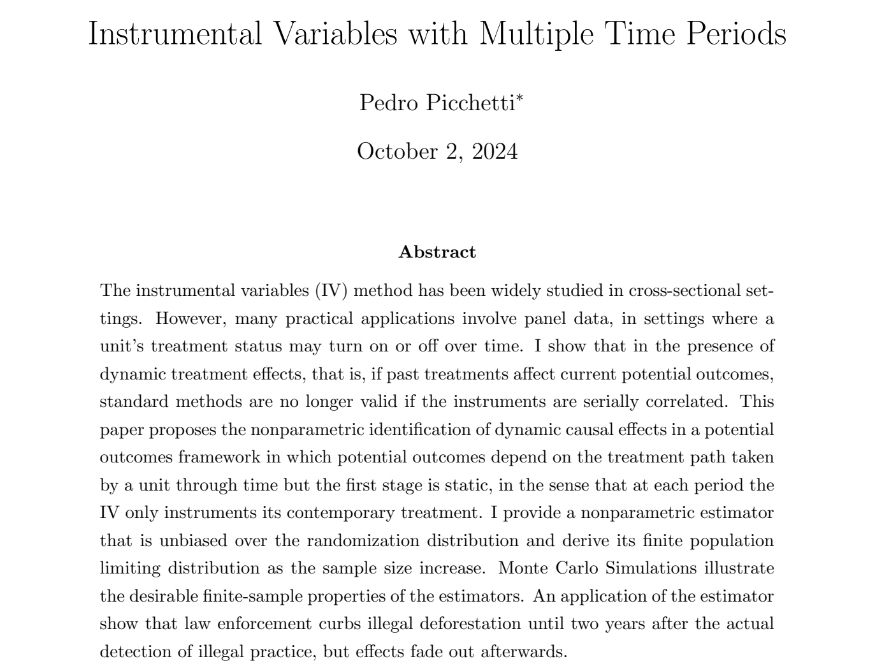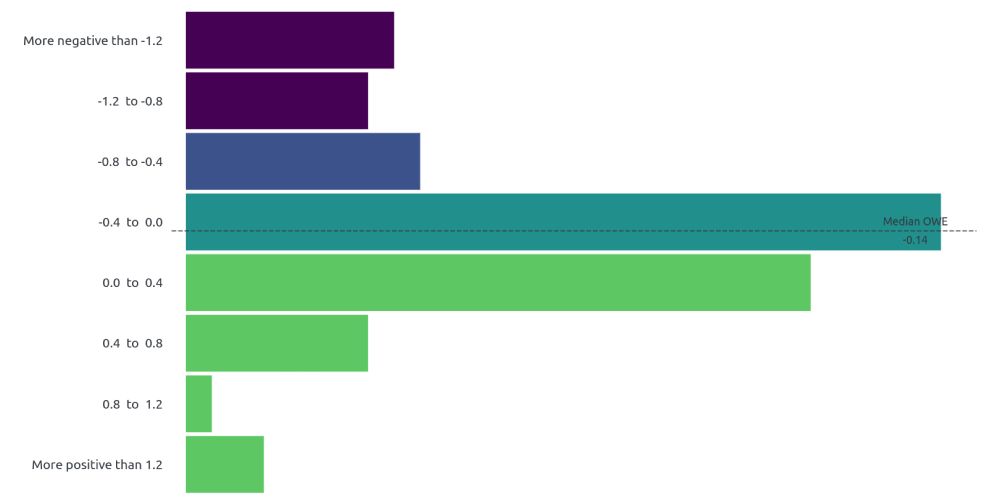The other difference is job hopping.
Men switch jobs more often than women during their lifecycles. However, women experience higher wage gains when they do switch.
Women need bigger incentives to switch jobs, a sign they might be not willing to move or are more risk-averse.
07.01.2025 13:56 — 👍 0 🔁 0 💬 1 📌 0

This changes at the top 0.1%!
The top 0.1% earners are mostly managers, regardless of gender.
To truly reach the top, managerial roles in the private sector are key, but women still face barriers to breaking into these positions.
07.01.2025 13:56 — 👍 0 🔁 0 💬 1 📌 0

The type of occupation matters!
Women who reach the top 1% are more likely to work in the public sector as public auditors, prosecutors, or members of the government in general.
On the other hand, men in the top 1% are much more likely to work as managers in the private sector.
07.01.2025 13:56 — 👍 0 🔁 0 💬 1 📌 0
What are the sources of this gender gap at the top?
One possible cause is that women work less than men.
Labor force participation is important to prevent women from reaching the top 1%, but once they reach the top, they work as much as men.
There must be something else…
07.01.2025 13:56 — 👍 0 🔁 0 💬 1 📌 0

The gender gap is pretty high at the top. The share of women in the labor force is about 38%, but in the top 1% is only 25%, and in the top 0.1% there is only 15% of women.
The glass ceiling is real, and it’s especially pronounced in Brazil.
07.01.2025 13:56 — 👍 0 🔁 0 💬 1 📌 0
It is not surprising that lifetime earnings inequality is stark in Brazil.
The top 1% earns about 166k BRL per year for over 26 years, the top 0.1% earns an astonishing 310k BRL PER YEAR!
07.01.2025 13:56 — 👍 0 🔁 0 💬 1 📌 0
Hence, we look at lifetime earnings, the earnings of 26 years of working in the formal sector.
Few papers look for a panel that long, so we are able to document the extent of lifetime income inequality, the work trajectory of these workers, in which occupation they worked, etc.
07.01.2025 13:56 — 👍 0 🔁 0 💬 1 📌 0
The gender gap depends on decisions and shocks that are dynamic and cumulative (children, unemployment).
Thus, looking at the cross-sectional distribution of income often overlooks the extent of inequality.
07.01.2025 13:56 — 👍 0 🔁 0 💬 1 📌 0

🚨 New paper alert! 🚨 (with @ursulamello.bsky.social and Antonio Martins-Neto)
It is time to document new facts about the gender gap in lifetime earnings among Brazil's top earners.
07.01.2025 13:56 — 👍 0 🔁 1 💬 1 📌 0
If you are in the market to hire an econometrician, Pedro is very talented one! Check his JMP!
04.10.2024 11:13 — 👍 1 🔁 0 💬 1 📌 0

The instrumental variables (IV) method has been widely studied in cross-sectional settings. However, many practical applications involve panel data, in settings where a unit's treatment status may turn on or off over time. I show that in the presence of dynamic treatment effects, that is, if past treatments affect current potential outcomes, standard methods are no longer valid if the instruments are serially correlated. This paper proposes the nonparametric identification of dynamic causal effects in a potential outcomes framework in which potential outcomes depend on the treatment path taken by a unit through time but the first stage is static, in the sense that at each period the IV only instruments its contemporary treatment. I provide a nonparametric estimator that is unbiased over the randomization distribution and derive its finite population limiting distribution as the sample size increase.
Hi all. I'm Pedro Picchetti from INSPER Institute of Research and Education, in Brazil. My #EconJMP provides a new method for the identification of dynamic causal effects using Instrumental Variables. sites.google.com/view/pedropi...
02.10.2024 14:22 — 👍 47 🔁 14 💬 0 📌 2
O principal problema é usar uma equação de identidade como uma equação causal.
Se eu mudar as importações não dá para saber se o PIB vai aumentar ou diminuir, talvez nem mude.
Para saber isso você precisa de uma teoria econômica + hipóteses e não uma equação contábil.
29.09.2024 19:50 — 👍 3 🔁 0 💬 0 📌 0
O paper do Winberry já mostrava que era possível, não? Acho que é mais uma questão de implementação user friendly.
26.09.2024 16:45 — 👍 1 🔁 0 💬 1 📌 0
E se... ...aumentássemos os salários oferecidos na construção?
24.09.2024 22:45 — 👍 2 🔁 0 💬 1 📌 0

If you are interested in learning more about minimum wages, Attila Lindner and I have a new, up-to-date review of the topic, coming out in the Handbook of Labor Economics.
Here's the @nberpubs working paper. Link: nber.org/papers/w32878
16.09.2024 12:24 — 👍 162 🔁 52 💬 10 📌 10
Interessante. Me surpreendeu alimento ser o que mais subiu (alta de demanda externa? não sei). Acho que nos EUA é saúde e educação os que mais subiram.
10.09.2024 17:11 — 👍 1 🔁 0 💬 0 📌 0

Minimum Wage Own Wage Elasticity Repository
Representative estimates from minimum wage studies
Pleased to introduce the own-wage elasticity repository for minimum wage studies: quantifies the employment effect in an economically interpretable way. Most studies suggest small effect on jobs.
Will be regularly updated. Joint with @benzipperer.org
1/
economic.github.io/owe/
09.09.2024 12:13 — 👍 66 🔁 31 💬 2 📌 5
Labor economist
Postdoctoral Researcher at ZEW – Leibniz Centre for European Economic Research (@zew.de)
PhD in Economics @uc3meconomics.bsky.social
https://sites.google.com/site/camilastfs/home
Sociologist, Ipea, IESP-UERJ. Inequality, top incomes, social mobility, poverty etc.
Energy & Environmental Economics, Development Economics. PhD Student in Public Policy at Carnegie Mellon University.
Site: https://sites.google.com/view/gabrielfmonteiro/
Economist at Bank of Spain; Previously at CUNEF and Spanish Ministry of Economy; Urban, Political, Labour; https://sites.google.com/site/federicocurci/home
Research Economist at Banco de España (Views are my own) | Interested in macro, firm dynamics, productivity, monetary policy and finance | PhD in Economics from Uc3m | Alumni UAH | Website: https://beatrizgonzalezlopez.weebly.com
Assistant Professor at the University of Chicago. Economics Ph.D. from UC3M.
Political Economist. My soul was always for History.
Personal webpage: https://t.co/b9M6GHB6H5
I review cardboard and cardboard accessories.
"Magic: The Gathering's #1 Most Tolerated Content Creator"
He/him
PhD Candidate in Economics at @Columbia B-School Mostly International Macroeconomics and Finance Lifelong learner
Economista investigador
📈 Impuestos • Economía pública | Public Finance • Taxation • Household Finance
El futuro está en los pueblos 🌾
serranopuente.eu
PhD student in economics at Stockholm University. www.thomasmikaelsen.com
Físico. PhD in Economics at @UC3M. Now @BancoDeEspana
RT&like≠endorsement. Usual disclaimers.
sites.google.com/view/rubenveiga
Associate Professor of Economics at UCY.
Interested in econ, politics, football, chess, random stuff, not necessarily in this order.
U Carlos III de Madrid prof, interested in life & work in frictional labor markets. http://ludovisschers.eu; team https://labourflows.co.uk/; Cesifo,IZA,EFI & Stone Centre; RT.ne.endorsed; Ordered my lattes in 🇳🇱 🇪🇺 🇪🇸 🏴 🇬🇧 🇨🇦 🇺🇸
Economics Professor at UC Berkeley; from #Ukraine
Calma! A tudo eu prefiro o meu cachorro
Economia | UNB | EESP-FGV
Vasco
Globalista provaxxer. Liberal em excesso, anti-estado, pro-indivíduo, anti-autoritarismo. Zoeira, Política, Reclamação. ML Officer at IJLB.
PhD UCSD Economics. Former IMF, Planalto, O Globo. Macro+Trade+Inequality. Bad ⚽️ tweets.
Economist: Labo(u)r, Macro, Inequality || Ass't Prof @MITSloan @MIT_IWER || Nonres fellow @piie
Minhas paixões são Vasco da Gama, Econometria e Sci-Fi.
PhD Student in Economics at Insper.
Economics | PhD student at Insper







